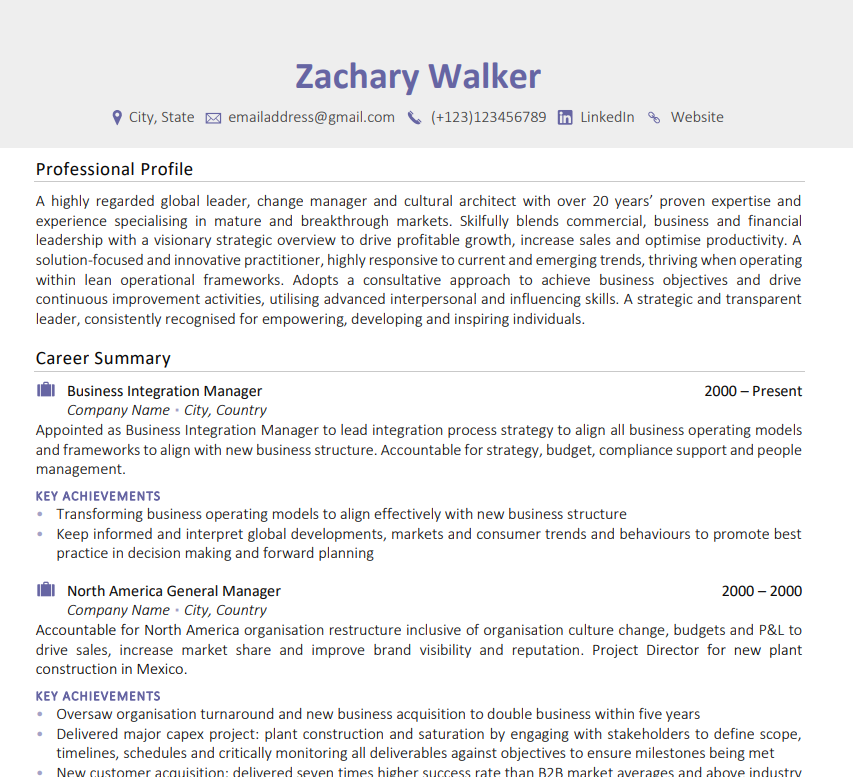How to Make Your CV Stand Out: 8 Proven Strategies for Success
With so many applications floating around out there, it’s frighteningly easy for yours to go unnoticed - even if you’re the perfect fit. The trick? Making sure your CV does you justice.
In this post, I’ll share eight proven strategies to help you create a CV that genuinely stands out - drawing on what I’ve learned from over 25 years of helping jobseekers put their best foot forward.
From showcasing your technical and soft skills to keeping everything up to date and tailored to the role, these practical strategies can help you write a CV that doesn’t just tick boxes but gets you noticed.
Ready to understand how to make your CV stand out? Let's get started.
Why a Standout CV Matters
Recruiters are busy people. They’re skimming through CVs at lightning speed, often with one eye on their inbox and the other on a lukewarm coffee. If your CV doesn’t catch their eye quickly, it’s probably being passed over for the next one in the pile.
Now, that might sound a bit grim, but here’s the good news: once you know what recruiters are looking for, you can absolutely give your CV the edge it needs.
How to Make Your CV Stand Out
Our top tips to help you craft a CV that’s clear, confident, and genuinely impressive.
Strategy 1: Proofread Thoroughly
You’d be surprised how many CVs are submitted with errors. A stray typo, a formatting inconsistency, or using “their” instead of “they’re”… these little things can give hiring managers the impression that you’re not as detail-oriented as you say you are.
Read your CV out loud. Step away from it for a few hours (or overnight, if you can) before checking it again. Better yet, ask someone you trust to give it a once-over.
And if you know spelling and grammar aren’t your strong suit, don’t worry. Tools like Grammarly can help catch basic errors, and of course, there’s always the option of getting a professional CV review (something we do every day at The CV Centre). A second opinion can make a world of difference.

Strategy 2: Tailor Your CV to the Job Description
If I could offer just one piece of advice, it would be this: never send the exact same CV to every job. It might feel efficient, but it’s one of the quickest ways to get overlooked.
Start by identifying the most relevant information for the role. That might include changing the way you describe your responsibilities, reordering sections, or even choosing to include one achievement and not another - depending on what’s most appropriate.
You should also look at the language they use in the job ad. Are they formal or casual? Do they talk about teamwork, innovation, customer service? Matching that tone helps show you're the cultural fit they’re after.
Straight away, this will make you stand out from the unedited, generic CVs being sent to them.
Strategy 3: Add a Strong Personal Statement
Think of your personal statement as your CV’s opening pitch. Done well, it can set the tone for the rest of your application and spark interest right from the top.
To write a winning personal statement that reflects you as an individual, put these four elements together:
How You Fit In
Mirror the language used in the job description - including the job title - as long as it’s true for you. This doesn’t mean changing your job titles in the work experience section, but it does mean aligning your statement with the role. If they’re looking for a “Junior Project Coordinator” and that’s what you are (or what you’re ready to be), then say so.
“Aspiring Junior Project Coordinator with experience managing student-led campaigns, keen to bring strong organisation and teamwork to a fast-paced agency environment."
What You Can Offer
Don’t just list your skills or experience, explain how you use them and the value you bring. The more specific, the better. You should also mention your most relevant qualifications here, as it's the first thing the hiring manager will see.
“With a BA (Hons) Business and Marketing degree, I am an aspiring Marketing Assistant - confident applying marketing principles such as audience targeting, A/B testing, and performance tracking to support campaign goals in a fast-paced environment.”
How It Feels To Work With You
Give a sense of your approach or working style. Are you collaborative? Calm under pressure? The kind of person who rolls up their sleeves and gets stuck in?
“I prioritise a hands-on, approachable leadership style that builds trust and motivates teams.”
Why You Care
Let your enthusiasm for the role or industry shine through naturally. Employers want to hire people who are genuinely invested in what they do.
“Passionate about creating great customer experiences and fostering team cultures where people thrive."
Strategy 4: Highlight Impressive Achievements
Your employment history isn’t just a list of jobs, it’s your chance to show the impact you’ve had. Instead of simply listing tasks like “managed the company’s social media accounts,” take it further by discussing your achievements. For instance:
“Grew Instagram following by 30% in three months through a targeted content strategy.”
Even if you’re earlier in your career, or your roles haven’t been particularly flashy, you’ve likely done more than you realise. Think about times when you solved a problem, improved a process, saved time, helped others, or received great feedback. Those are all wins, and they count.
Strategy 5: Use Action Verbs
If CV is sounding a bit like a job description and not much like you, it’s time to inject a little life into your language. And that’s where action verbs come in - the more powerful the better.
For example, instead of the following sentence with just one, fairly common action verb:
“Responsible for updating the website.”
Try:
“Facilitated a refresh of the company website, rewriting key landing pages and coordinating with designers to improve layout."
Don’t worry if you haven’t managed entire projects yet. Action verbs still apply, for example:
“Revamped product listings and coordinated image uploads for a seasonal campaign, helping the team improve consistency and prepare the site for increased traffic.”
They help you to get specific on exactly how you were involved in the company, whilst adding energy into your CV.
Strategy 6: Include a Relevant Skills Section
Recruiters are often short on time and skimming for specific skills. That’s why including a dedicated skills section can help you to stand out, ideally near the top of your CV.

If you’re changing industries or still early in your career, this is where your transferable skills can really shine. Maybe you haven’t worked in sales before, but you’ve got strong communication skills, you’re confident presenting, and you know how to handle tricky situations with a smile. That’s relevant, and it counts.
Strategy 7: Incorporate Keywords
Applicant Tracking Systems (ATS) are commonly used in the hiring process to scan CVs for specific keywords and phrases that match the job description. If those keywords aren’t there, your CV might never reach a real person, no matter how brilliant you are.
The good news? Humans like keywords too. Recruiters are scanning for the same key skills, tools, and qualifications that you’ll often find in the job advert or the person specification.
Read the job advert carefully, and make a note of recurring words or phrases, especially those tied to responsibilities, qualifications, and core skills. These are your golden keywords. Then, weave them naturally into your CV to make it past both humans and ATS software.
Strategy 8: Focus on Design and Layout
According to an eye-tracking study, CVs with cluttered layouts, minimal white space and long, dense sentences didn't fare well with recruiters. In short? If your CV is hard to read, it’s likely to be skipped. But once you understand what does work visually, you can make sure your CV stands out for the right reasons.
Align everything neatly and use clear section headers like “Work Experience”, “Skills”, and “Education” to help guide the reader through. Remember to keep things concise - if your CV is packed with text or goes into too much detail, you risk losing the reader halfway down the page.
Want a deeper dive into layout, formatting tips, and the ideal CV structure? Read our full blog post on how to write a CV. It walks you through everything you need to know, step by step.

Next Steps: Transform Your Career with The CV Centre
Ready to stop second-guessing your CV and start getting real results?
You’ve already done the hard part - gaining the skills, the experience, and the ambition. Now you just need a CV that brings it all together in a way that grabs attention and opens doors.
Whether you’re struggling to frame your experience, unsure how to tailor your CV, or just feel like it’s missing something, we can help. From keyword-optimised layouts to punchy personal statements and achievement-led bullet points, we know what hiring managers want and how to help you deliver it.
Get a professionally written CV that makes your strengths shine, or request a FREE expert review and discover what’s holding you back.
Frequently Asked Questions
I've gone through some of the most common questions on making your CV stand out below.
How Long Should My CV Be To Stand Out?
Your CV should usually be 1–2 pages. If you’re a graduate or early in your career, one page is best. For those with more experience, two pages is also acceptable.
Certain roles, like in academia or medicine, may require more. But for most jobs, shorter is better - recruiters often skim CVs quickly, so make every word count.
How Can I Make My CV Look Impressive?
To make your CV look impressive, focus on clarity, structure, and relevance. Use tidy headings, avoid walls of text, and highlight relevant achievements, not just tasks. A well-laid-out, honest CV that tells your story with purpose? That’s impressive.
Why Is My CV Not Getting Noticed?
If your CV isn’t getting noticed, it could be too generic, missing keywords, or not quite hitting the mark with layout. Make sure it aligns with each job you apply for and includes clear examples of what you bring to the table.

